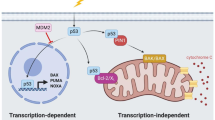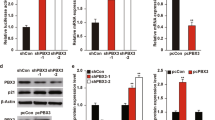Abstract
A key difference among the three structurally similar pRB family members is that only pRB is a tumor suppressor. Identification of distinctive functional differences between pRB and p107/p130 therefore holds promise for a better understanding of the tumor suppression mechanisms of pRB. Enigmatically, pRB and p107 have been shown to have indistinguishable growth suppression activities when studied in the pRB-deficient Saos-2 cell system. In this study, we discovered that, when expressed at physiologically relevant levels, pRB and p107 had distinctive effects in causing growth suppression. pRB induced cellular p130 levels while p107 repressed them. p107, but not pRB, blocked cells inside S phase in addition to G1 arrest. In contrast, no qualitative differences were identified in their abilities to repress the expression of a set of suspected pRB/E2F repression target genes. These results indicate that pRB and p107 possess different growth suppression effects, despite the fact that they have similar E2F repression effects.
This is a preview of subscription content, access via your institution
Access options
Subscribe to this journal
Receive 50 print issues and online access
$259.00 per year
only $5.18 per issue
Buy this article
- Purchase on Springer Link
- Instant access to full article PDF
Prices may be subject to local taxes which are calculated during checkout







Similar content being viewed by others
References
Ausubel FM, Brent R, Kingston RE, Moore DD, Seidman JG, Smith JA and Struhl K. . 1990 Current Protocols in Molecular Biology, Wiley Interscience.
Baldi A, Boccia V, Claudio PP, De Luca A and Giordano A. . 1996 Proc. Natl. Acad. Sci. USA 93: 4629–4632.
Beijersbergen RL, Kerkhoven RM, Zhu L, Carlée L, Voorhoeve PM and Bernards R. . 1994 Genes Dev. 8: 2680–2690.
Blagosklonny MV, Wu GS, Omura S and el-Deiry WS. . 1996 Biochem. Biophy. Res. Com. 227: 564–569.
Buchmann AM, Swaminathan S and Thimmapaya B. . 1998 Mol. Cell. Biol. 18: 4565–4576.
Clarke A, Maandag E, van Roon M, van der Lugt N, van der Valk M, Hooper M, Berns A and te Riele H. . 1992 Nature 359: 328–330.
Claudio PP, Howard CM, Baldi A, De Luca A, Fu Y, Condorelli G, Sun Y, Colburn N, Calabretta B and Giordano A. . 1994 Cancer Res. 54: 5556–5560.
Colbrinik D, Lee M-H, Hannon G, Mulligan G, Bronson RT, Dyson N, Harlow E, Beach D, Weinbert RA and Jacks T. . 1996 Genes Dev. 10: 1633–1644.
Cobrinik D, Whyte P, Peeper DS, Jacks T and Weinberg RA. . 1993 Genes Dev. 7: 2392–2404.
Datta PK, Raychaudhuri P and Bagchi S. . 1995 Mol. Cell. Biol. 15: 5444–5452.
Dynlacht BD, Moberg K, Lees JA, Harlow E and Zhu L. . 1997 Mol. Cell. Biol. 17: 3867–3875.
Dyson N. . 1994 J. Cell. Sci. 18: S81–S87.
Ewen M, Faha B, Harlow E and Livingston D. . 1992 Science 255: 85–87.
Faha B, Ewen M, Tsai L-H, Livingston D and Harlow E. . 1992 Science 255: 87–90.
Foley KP, Leonard MW and Engel JD. . 1993 Trends Genet. 9: 380–385.
Garriga J, Limon A, Mayol X, Rane SG, Albrecht JH, Reddy EP, Andres V and Grana X. . 1998 Biochem. J. 333: 645–654.
Ginsberg D, Vairo G, Chittenden T, Xiao Z-X, Xu G, Wydner KL, DeCaprio JA, Lawrence JB and Livingston DM. . 1994 Genes Dev. 8: 2665–2679.
Goodrich DW, Wang NP, Qian Y-W, Lee EY-HP and Lee W-H. . 1991 Cell 67: 293–302.
Gossen M and Bujard H. . 1992 Proc. Natl. Acad. Sci. USA 89: 5547–5551.
Gu W, Schneider JW, Condorelli G, Kaushai S, Mahdavi V and Nadal-Ginard B. . 1993 Cell 72: 309–324.
Harper JW, Adami GR, Wei N, Keyomarsi K and Elledge SJ. . 1993 Cell 75: 805–816.
Helin K, Wu C, Fattaey A, Lees J, Dynlacht B, Ngwu C and Harlow E. . 1993 Genes Dev. 7: 1850–1861.
Herrera RE, Sah VP, Williams BO, Makela TP, Weinberg RA and Jacks T. . 1996 Mol. Cell. Biol. 16: 2402–2407.
Hijman EM, Voorhoeve PM, Beijersbergen RL, Veer LJ and Bernards R. . 1995 Mol. Cell. Biol. 15: 3082–3089.
Hinds PW, Mittnacht S, Dulic V, Arnold A, Reed SI and Weinberg RA. . 1992 Cell 70: 993–1006.
Huang HJ, Yee JK, Shew JY, Chen PL, Bookstein R, Friedmann T, Lee EY and Lee WH. . 1988 Science 242: 1563–1566.
Hurford RK, Cobrinik D, Lee M-H and Dyson N. . 1997 Genes Dev. 11: 1447–1463.
Iavarone A and Massague J. . 1999 Mol. Cell. Biol. 19: 916–922.
Jacks T, Fazeli A, Schmitt E, Bronson R, Goodell M and Weinberg R. . 1992 Nature 359: 295–300.
Jiang H, Chou HS and Zhu L. . 1998 Mol. Cell. Biol. 18: 5284–5290.
Koh J, Enders GH, Dynlacht BD and Harlow E. . 1995 Nature 375: 506–510.
Lacy S and Whyte P. . 1997 Oncogene 14: 2395–2406.
LeCouter JE, Kablar B, Hardy WR, Ying C, Megeney LA, May LL and Rudnicki MA. . 1998a Mol. Cell. Biol. 18: 7455–7465.
LeCouter JE, Kablar B, Whyte PF, Ying C and Rudnicki MA. . 1998b Development 125: 4669–4679.
Lee EY-HP, Chang C-Y, Hu N, Wang Y-CJ, Lai C-C, Herrup K, Lee W-H and Bradley A. . 1992 Nature 359: 288–294.
Lee M-H, Williams BO, Mulligan G, Mukai S, Bronson RT, Dyson N, Harlow E and Jacks T. . 1996 Genes Dev. 10: 1621–1631.
Lees JA, Saito M, Vidal M, Valentine M, Look T, Harlow E, Dyson N and Helin K. . 1993 Mol. Cell Biol. 13: 7813–7825.
Lukas J, Parry D, Aagaard L, Mann DJ, Bartkova J, Strauss M, Peters G and Bartek J. . 1995 Nature 375: 503–506.
Mayol X, Garriga J and Grana X. . 1995 Oncogene 11: 801–808.
Mayol X, Garriga J and Grana X. . 1996 Oncogene 13: 237–246.
Medema RH, Herrera RE, Lam F and Weinberg RA. . 1995 Proc. Natl. Acad. Sci. USA 92: 6289–6293.
Mulligan G and Jacks T. . 1998 Trends Genet. 14: 223–229.
Nevins JR. . 1998 Cell Growth Diff. 9: 585–593.
Novitch BG, Mulligan GJ, Jacks T and Lassar AB. . 1996 J. Cell. Biol. 135: 441–456.
Pagano M, Tam SW, Theodoras AM, Beer-Romero P, Del Sal G, Chau V, Yew PR, Draetta GF and Rolfe M. . 1995 Science 682–685.
Qin X-Q, Chittenden T, Livingston D and Kaelin WG. . 1992 Genes Dev. 6: 953–964.
Robanus-Maandag E, Dekker M, van der Valk M, Carrozza ML, Jeanny JC, Dannenberg JH, Berns A and te Riele H. . 1998 Genes Dev. 12: 1599–1609.
Schneider JW, Gu W, Zhu L, Mahdavi V and Nadal-Ginard B. . 1994 Science 264: 1467–1471.
Sellers WR, Novitch BG, Miyake S, Heith A, Otterson GA, Kaye FJ, Lassar AB, Kaelin WGJ and Sellers WR. . 1998 Genes Dev. 12: 95–106.
Smith EJ, Leone G and Nevins JR. . 1998 Cell Growth Diff. 9: 297–303.
Tiemann F and Hinds PW. . 1998 EMBO J. 17: 1040–1052.
Toyoshima H and Hunter T. . 1994 Cell 78: 67–74.
van den Heuvel S and Harlow E. . 1993 Science 262: 2050–2054.
Vigo E, Muller H, Prosperini E, Hatebor G, Cartwright P, Moroni MC and Helin K. . 1999 Mol. Cell. Biol. 19: 6379–6395.
Weinberg RA. . 1995 Cell 81: 323–330.
Woo MS, Sanchez I and Dynlacht BD. . 1997 Mol. Cell. Biol. 17: 3566–3579.
Zhu L, Enders G, Lees JA, Beijersbergen RL, Bernards R and Harlow E. . 1995a EMBO J. 14: 1904–1913.
Zhu L, Harlow E and Dynlacht BD. . 1995b Genes Dev. 9: 1740–1752.
Zhu L, van den Heuvel S, Helin K, Fattaey A, Ewen M, Livingston D, Dyson N and Harlow E. . 1993 Genes Dev. 7: 1111–1125.
Acknowledgements
We thank all colleagues who contributed to our studies by providing us with invaluable reagents (acknowledged in Materials and methods), and D Gebhard for assistance with FACS analysis. We thank Oyinkansola Ogunrinde for constructing the pUHD10-3p130 plasmid. L Zhu is indebted to Ed Harlow, in whose laboratory the first pRB inducible cell line was established. This work was supported by the American Cancer Society Research Project Grant (97-125-01). Albert Einstein Comprehensive Cancer Research Center Grant provided support for core services. AN Karnezis is supported by the Medical Scientist Training Program at the Albert Einstein College of Medicine and L Zhu is a Leukemia & Lymphoma Society Scholar.
Author information
Authors and Affiliations
Rights and permissions
About this article
Cite this article
Jiang, H., Karnezis, A., Tao, M. et al. pRB and p107 have distinct effects when expressed in pRB-deficient tumor cells at physiologically relevant levels. Oncogene 19, 3878–3887 (2000). https://doi.org/10.1038/sj.onc.1203722
Received:
Revised:
Accepted:
Published:
Issue Date:
DOI: https://doi.org/10.1038/sj.onc.1203722
Keywords
This article is cited by
-
Polyamine depletion induces G1 and S phase arrest in human retinoblastoma Y79 cells
Cancer Cell International (2008)
-
Phosphorylation of pRB at Ser612 by Chk1/2 leads to a complex between pRB and E2F-1 after DNA damage
The EMBO Journal (2007)
-
Re-expression of hSNF5/INI1/BAF47 in pediatric tumor cells leads to G1arrest associated with induction of p16ink4a and activation of RB
Oncogene (2002)



